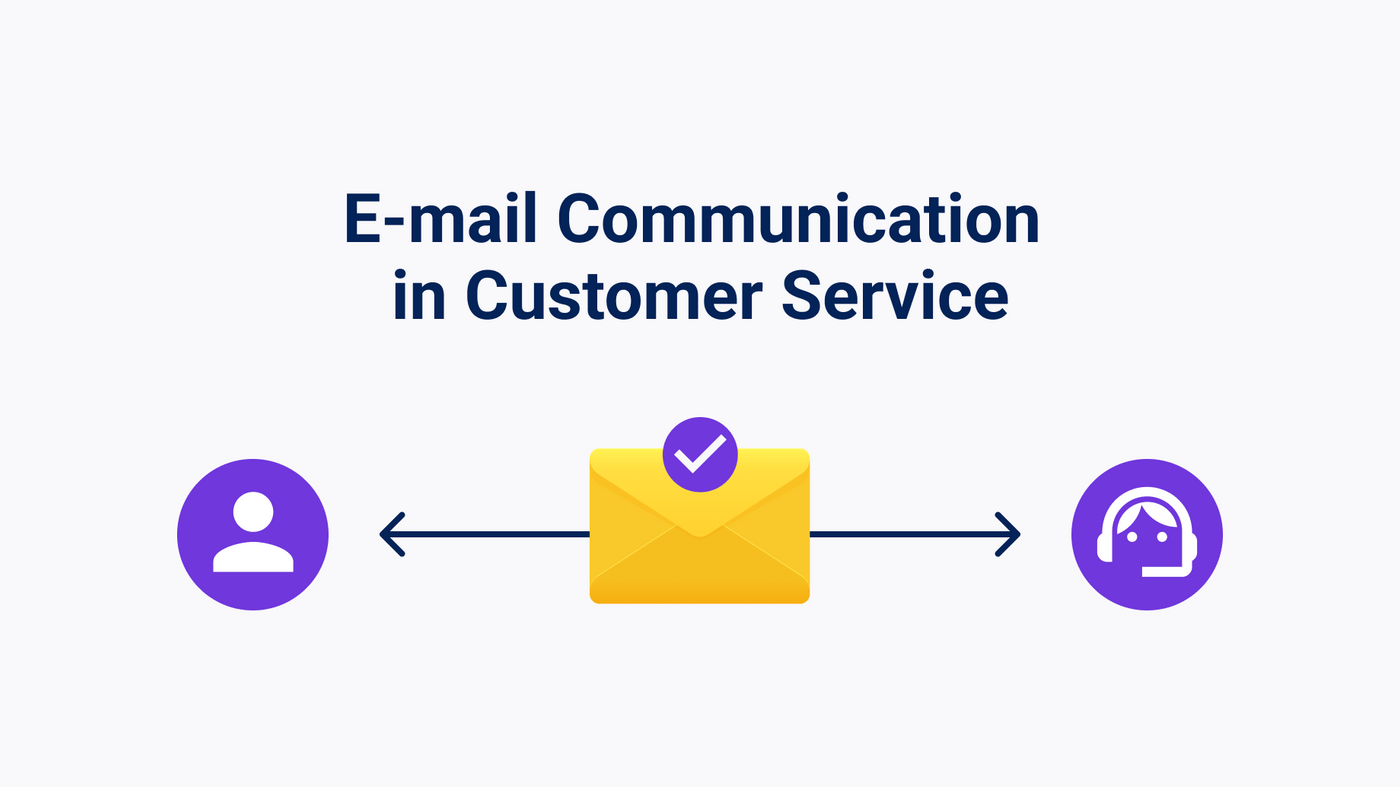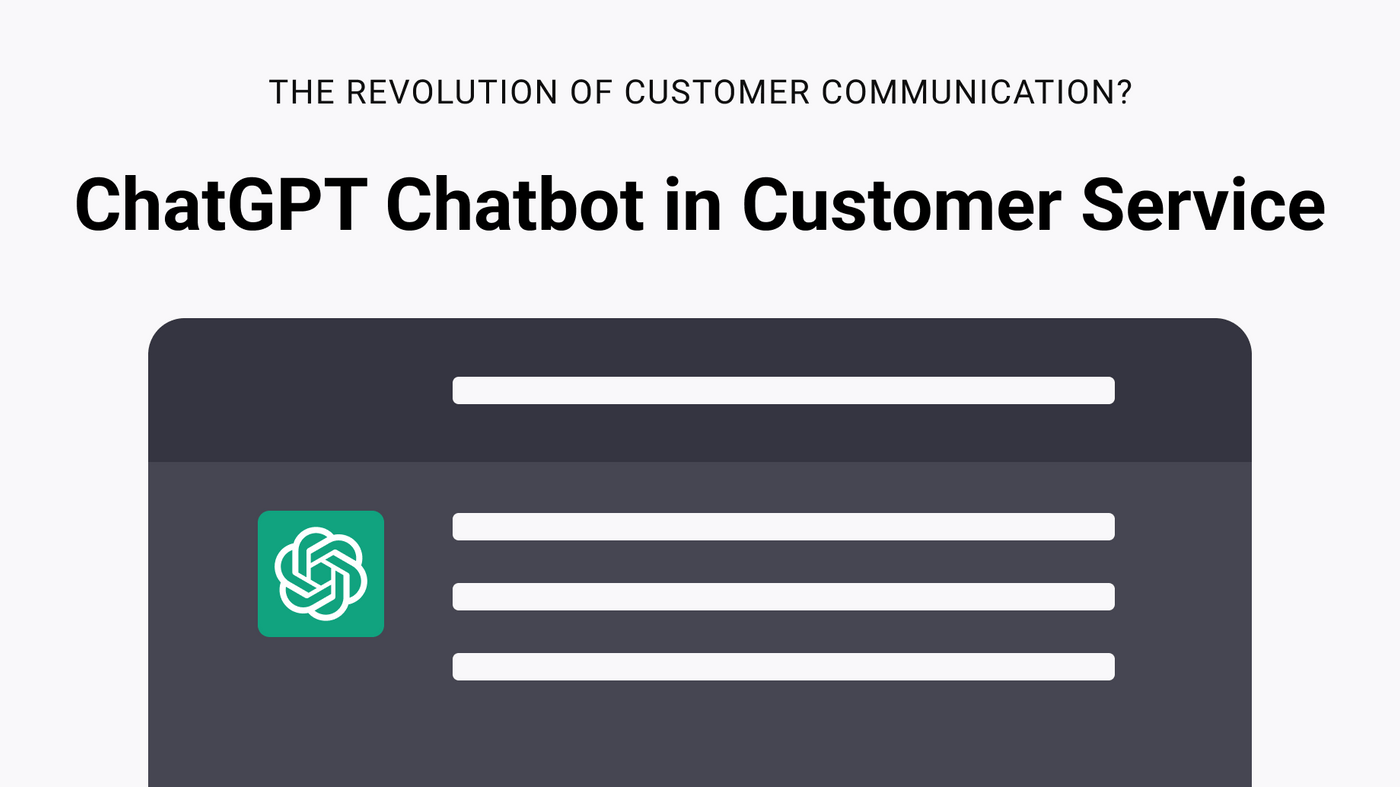News
GPT-4 Chatbot for Customer Service | The New ChatGPT Beta Chatbot in Test
The ChatGPT-level chatbot based on OpenAI's powerful GPT-4 engine revolutionizes chatbot communication and makes interactions more efficient in customer service.
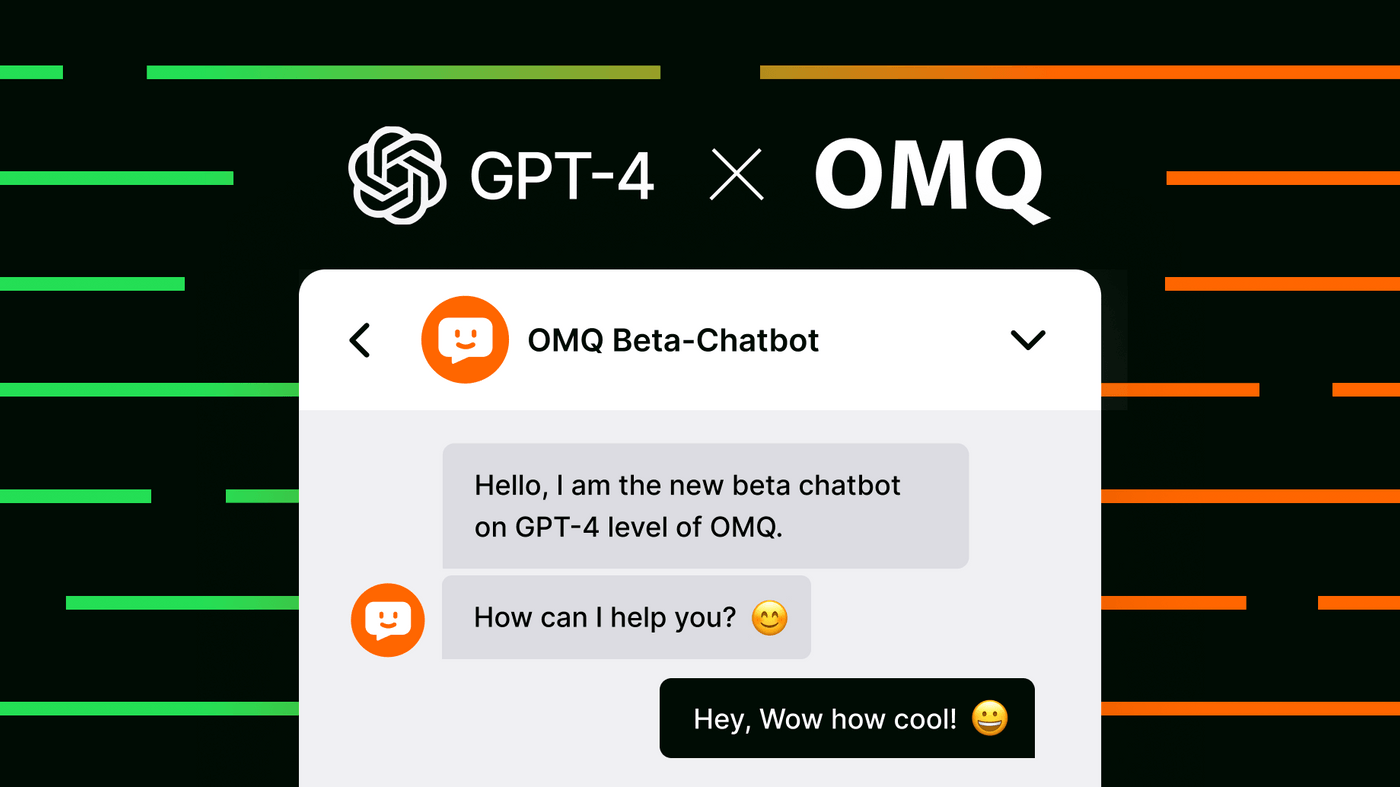
A few weeks ago, we published an article about ChatGPT in which we talked about the platform in general and asked ourselves what challenges still need to be solved in order to be able to use this technology in customer service. We also promised a series of articles on the topic.
Since then we have been working on the beta version of a ChatGPT chatbot, which we would also like to present now in the 2nd article of this series. Our beta-chatbot is based on OpenAI’s latest model: GPT 4.
Update from 05/17/2023
Our GPT-4 chatbot for customer service is now available! Here you can test the new OMQ chatbot on GPT-4 level now live.
You want to use the new chatbot in your company? No problem - our GPT-4 chatbot is now available! Make an appointment with us and learn more about application possibilities and pricing.
Recap: State of the 1st article - Optimize ChatGPT for customer service.
In the first article on ChatGPT we came to the conclusion that the GPT technology is not yet adapted to customer service and there are still some points that need improvement. We have also shown how these challenges can be solved:
- Provide current knowledge
- Guide to truthful answers
- Optimize the use of LLM
- Train for specific support tasks
Our development team has worked on the optimization of these aspects in the past weeks. We believe that our beta version is well on its way to significantly improving customer support. I was allowed to pre-test the ChatGPT level chatbot and am happy to tell you about it.
The beta version of OMQ ChatGPT level chatbot
It appears as if the new GPT-4 chatbot hardly differs from its predecessor when starting the chat. As before, the ChatGPT level chatbot is also in a normal chat window. The special feature is not the design, but the interaction. Communication now runs much smoother and faster. There is one crucial difference: Previously, we used an internal engine, which we have now replaced with a GPT-4 engine. This can be tried out in the beta test.
What I noticed right away is that there is no longer a choice to narrow down the questions. The bot no longer asks: “Do you mean X, Y, Z?”, but answers the question or asks suitable counter-questions. So while before there were several suggestions for possibly matching questions, the chatbot now answers, for example, “Thank you for shopping with me! What can I help you with on the machine when making a purchase?”
We are very proud to be the first German company to provide our customers with this chatbot using the latest AI technology based on ChatGPT/GPT-4.Matthias Meisdrock, CEO of OMQ
You can test the GPT-4 beta chatbot now
Are you curious what the new GPT-4 beta chatbot from OMQ can do? Then test it yourself and convince yourself of the fantastic new features. Make an appointment directly with us and get excited about the new technology.
Up-to-date knowledge and individual responses with ChatGPT
Unlike the OpenAI ChatGPT, this beta bot is able to output up-to-date information about the customer service of the respective companies. When the chatbot answers my questions, it can use different formulations. It does not resort to pre-made answers, but uses the new GPT technology to answer my questions independently. In doing so, it can also respond to questions I asked a few days ago without any problems, because the new GPT chatbot doesn’t just respond to input like the previous models, but recognizes previous messages through AI. So the conversation is very natural now. You don’t even notice that you’re communicating with a chatbot, as it shows a real understanding of the content.
Use Case E-Commerce
““Hello, I live in Norway. I would like to buy the Caffesimo NEW. Do you offer shipping to Norway? If so, how much does it cost?“
Before it showed a prepared answer: „Do you ship abroad“ and/or „How much is the shipping cost“, and let the human user choose one.
The new GPT technology now reads both entries, links them, and then responds: “Yes, we ship to Norway. For shipping abroad (outside Germany), there is an additional shipping cost of 19 euros.”
Optimal adaptation of ChatGPT to digital customer service
Unlike ChatGPT, the ChatGPT level chatbot has a very specific goal and was programmed to improve customer service. Thus, the various features have also been optimally adapted to support. So the messages now look authentic and also offer real info, while the typical OpenAI chat also likes to spread untruths sometimes.
Specific support tasks with OMQ Automator
Another great feature that the bot is now capable of is performing actions, because we have integrated our OMQ Automator. Among other things, notices can be registered, spare parts can be ordered, postal codes can be searched for, or nearby offices can be found simply by chatting. The chatbot performs these actions in the background and the users do not even have to contact human employees or be referred to different pages.
Smooth transition from one language to another
In the future, it will also be possible to simply switch back and forth between languages. The bot does not have to be asked to answer in a different language. If customers formulate their question in English or French, for example, the chatbot will then answer them directly accordingly and adapt to their needs.
Example #1 for ChatGPT in customer service
The chatbot with GPT-4 technology answers the customer’s questions truthfully and is also able to link later questions with previous input. Even colloquial phrases can be picked up in this way. Our first example shows such a conversation:
Example #2 for ChatGPT in customer service
Our second example shows that the bot can handle and implement unconventional queries, such as ordering by alphabetical order.
Example #3 for ChatGPT in customer service
The GPT 4-Level-Chatbot can ask questions that are individually adapted to the customer and appear naturally in the conversation.
Example #4 for ChatGPT in customer service
In addition, the AI bot is able to forward customers to partners of the respective company if required.
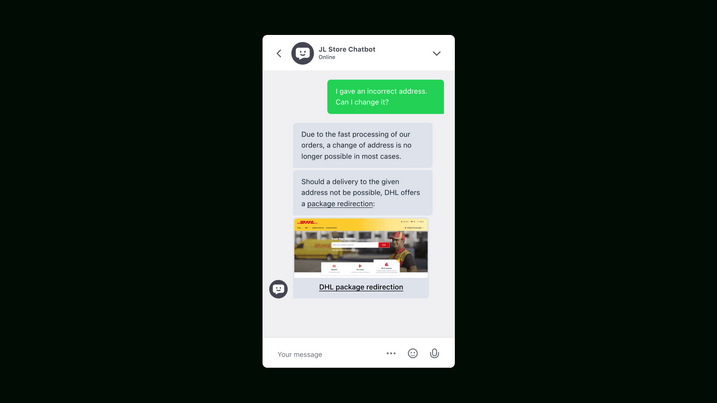
The GPT-4 beta chatbot displays links to DHL parcel redirection.
What is ChatGPT able to do? Interview with the machine learning researcher who developed the new beta chatbot
While I was trying out the chat myself, I was also able to talk to our developer Gil and ask him some questions. He was able to explain to me some of the processes that are now different from the legacy bot.
Yasmin: ChatGPT is very helpful, but sometimes gives out wrong information. Of course, this is not good for customer service, right?
Dr. Noh: That’s right. The problem with Large Language Models is that they confidently write and output things that look authentic. However, looking authentic does not mean that they are then correct or true to the facts. In some areas this might be okay, like when chatting just for fun, just looking for information, or for essay writing (if you correct the incorrect information afterwards). But for customer service, this is bad. So, for areas like customer support, specific additional steps are required to ensure that all expenses are in line with support policies and facts. The model should be instructed to read and generate only true facts (e.g., only those contained in the managed knowledge base, such as the OMQ knowledge base) and not make things up, etc.
Large Language Models are AI systems based on natural language processing and understanding. They are trained to analyze large amounts of text from various sources to generate human-like responses and text in different languages. Examples of large language models include OpenAI’s GPT-3 or Google’s BERT.
These models use neural networks, specifically transformer architectures, to identify patterns and relationships in training data. By training with billions of words and sentences, they can understand complex relationships in natural language, including grammar, syntax, and semantic meanings.
Yasmin: ChatGPT keeps emphasizing that it was only filled with current knowledge until 2021, but the OMQ chatbot seems to have current knowledge. What is the main difference between the two versions?
Dr. Noh: ChatGPT is very capable, but it is also limited in the sense that it does everything it does with its “memory” alone. Imagine the chatbot is an employee and is only allowed to respond with answers from a support manual (= OMQ knowledge base). Everything it outputs is based on this manual. If a manager updates this book (e.g. shipping increases from 5 to 9€), the chatbot always has the latest update and uses it to output up-to-date information.
Yasmin: GPT-4 has been introduced and is stronger than GPT-3. Will the technology get better and better until it becomes a “super human”?
Dr. Noh: The reason GPT (from GPT3) were so exciting was that they were NOT explicitly trained to draw conclusions or answer questions - they were just trained to predict the next words and sentences. This gives rise to many new features, such as near-perfect knowledge of how to write sentences, understanding of many facts, ability to respond in natural language, etc. The GPT technology is able to read or predict texts - and it does it very well. As a result, relatively unexpected capabilities suddenly emerged. With some refinements, the latest GPT models then became general “language understanding machines.”
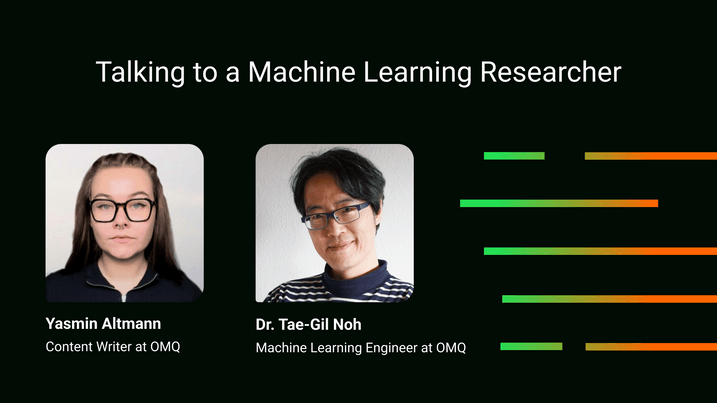
Yasmin Altmann in conversation with Dr. Tea-Gil Noh from OMQ.
And yes, this technology is indeed getting better and better. That AI is gaining more and more knowledge and skills not only on the level of language, but also on the level of the so-called “understanding of the world”, and possibly even reaching and surpassing human capabilities, is so far a “wishful thinking” with the term “Artificial General Intelligence” (AGI). Many researchers seriously believe in it and try to add more data about the world, such as images, bodies (in real robots or in simulations), sounds and videos, into these databases to train a better “understanding” of the world. Some researchers:inside do not believe in this and see that the current neural network-based approach has clear limitations. They refer to language models as “stochastic parrots” that know nothing, but only say things that sound right.
I personally believe that a “general world machine” is achievable. That is, a GPT-like machine for every aspect of our lives, not just speech, but also sound, music, visuals, motion, and so on. However, I don’t think we will reach a “superhuman” level in the process, at least not in the way we are currently training the models.
Instead of a new revolutionary level (e.g., emerging capabilities), I expect chat GPT-level technology to emerge in every aspect of our lives. And that, in turn, will change how we work, communicate, and process data.
Benefits of the OMQ GPT-4 Beta Chatbot in a nutshell
- Natural language communication
- Conversations can always be continued
- Answers are more natural and complex
- understanding and immediate response
- flexible and creative responses to customer requests
- smooth transition to other languages
We believe that our new ChatGPT / GPT-4 chatbot will help our customers improve their customer relationships by providing fast, efficient and personalized responses to customer inquiries.Matthias Meisdrock, CEO of OMQ
Now it’s your turn - test the new GPT-4 chatbot from OMQ
You can test the chatbot from OMQ on GPT-4 level now. Just leave us a short message or arrange a call directly. We will get back to you with all the information you need for testing.
What’s next?
Wow. All this input sounds pretty good. In the future, our beta chatbot will of course be developed and improved. We’re already looking forward to the customer feedback!
In our next article in our ChatGPT series, we will talk about the future of customer support and service agents with ChatGPT and the latest developments in OpenAI.

